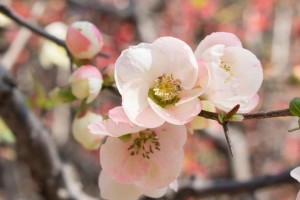 Winter has temporarily abated, with temperatures consistently above freezing and even jumping into spring-like territory. The weekend looks promising. It is past time for me to prune the flowering quince.
Winter has temporarily abated, with temperatures consistently above freezing and even jumping into spring-like territory. The weekend looks promising. It is past time for me to prune the flowering quince.
That sounds like a perfectly reasonable thing to do, and it would be, except for one small detail—the flowering quince, or Chaenomeles speciosa, is armed and dangerous. The now-bare branches of this deciduous shrub are laden with thorns. Those sharp stemmed projections are not just your garden variety rose barbs, but needle-pointed prickles, each of which is a couple of inches long. Not only is pruning the quince perilous, but getting rid of the branches is difficult. They rip even the sturdiest garden waste bags as if they were tissue and don’t break down easily in the compost pile, even when the branches are chopped into relatively small lengths. Chipping them is probably the best way, but I don’t have a chipper/shredder yet. Given that the quince is not going anywhere, I may have to invest in one.
Flowering quince comes by its barbed nature honestly, because it is a card-carrying member of the rose or Rosaceae family. Its relatives include the often thorny garden rose, not to mention such prickly horticultural specimens as blackberries and raspberries. Of course, it is also related to fruiting quince or Cydonia oblonga, which does not have thorns. Flowering quince is probably a little more beautiful in bloom than its fruiting relative. Perhaps the thorns are simply the price of beauty.
Philosophical considerations aside, my quince is too big. It is a large, spreading shrub, currently about seven feet tall and six feet wide. Its topmost branches are festooned with sweet autumn clematis, an opportunistic, self-sown vine that pays its way by flowering beautifully in the fall and providing interesting seedheads thereafter. Like the quince, the sweet autumn clematis covers more territory every year.
Pruning the shrub will inevitably result in loss of much of the clematis, but since the vine is virtually unkillable, I am not worried. The job will also deprive me and the neighborhood of many spring blossoms, and that bothers me a bit. While the topmost branches would not have borne flowers until next year, the pruning effort has to extend to mature, flower-bearing stems. I can see the little buds already, even though they are unlikely to unfurl for at least eight weeks.
Still, I have neglected serious quince pruning for a couple of years and that means that necessary losses will occur. It is too soon to save some of those branches by plunging them into water and “forcing” them into early bloom, so they will be casualties of the process. The sad truth is that nature and pruning are always about short-term loss in the service of longer term gain.
The loss that really concerns me is blood loss. To make this less likely, I will don my elbow-length rose gauntlets for the job and use long-handled loppers. I have no intention of getting up close and personal with the branches as I prune, either. Barring the arrival of a chipper-shredder, I will chop the pruned branches into short lengths, compost them, and hope for the best.
I anthropomorphize plants too much, but I know that the quince will not mind being barbered and will only be semi-tamed. The remaining branches will go about the task of fulfilling the biological imperative and producing the pink buds that will ultimately lead to pinkish white flowers. A few branches will revert to the deeper coral color of some of their quince forbearers. The oval-shaped leaves will cloak those branches and the long thorns will do their job, whatever that may be. I suspect that they protected ancient quinces from predators.
Though flowering quince is supposed to be sterile, a few of those quince flowers will be pollinated and produce fruit. Last year my harvest was about ten golden-green quinces of varying sizes. If that happens again this year, perhaps I will finally make a batch of sweet quince paste, or membrillo, to serve with cheese next winter. It will be a sweet reward for the prickly job of the taming of the quince.
